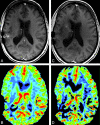Does MR perfusion imaging impact management decisions for patients with brain tumors? A prospective study
- PMID: 22116105
- PMCID: PMC7966417
- DOI: 10.3174/ajnr.A2811
Does MR perfusion imaging impact management decisions for patients with brain tumors? A prospective study
Abstract
Background and purpose: MR perfusion imaging can be used to help predict glial tumor grade and disease progression. Our purpose was to evaluate whether perfusion imaging has a diagnostic or therapeutic impact on clinical management planning in patients with glioma.
Materials and methods: Standard MR imaging protocols were interpreted by a group of 3 NRs in consensus, with each case being interpreted twice: first, including routine sequences; and second, with the addition of perfusion imaging. A multidisciplinary team of treating physicians assessed tumor status and created hypothetical management plans, on the basis of clinical presentation and routine MR imaging and then routine MR imaging plus perfusion MR imaging. Physicians' confidence in the tumor status assessment and management plan was measured by using Likert-type items.
Results: Fifty-nine consecutive subjects with glial tumors were evaluated; 50 had known pathologic diagnoses. NRs and the treatment team agreed on tumor status in 45/50 cases (κ = 0.81). With the addition of perfusion, confidence in status assessment increased in 20 (40%) for NRs and in 28 (56%) for the treatment team. Of the 59 patient-care episodes, the addition of perfusion was associated with a change in management plan in 5 (8.5%) and an increase in the treatment team's confidence in their management plan in 34 (57.6%). NRs and the treatment team found perfusion useful in most episodes of care and wanted perfusion included in future MR images for >80% of these subjects.
Conclusions: Perfusion imaging appears to have a significant impact on clinical decision-making and subspecialist physicians' confidence in management plans for patients with brain tumor.
Figures




References
-
- Central Brain Tumor Registry of the United States. CBTRUS Statistical Report: primary brain and central nervous system tumors diagnosed in the United States in 2004–2007. 2011. http://www.cbtrus.org. Accessed 2011 Feb 21.
-
- Reardon DA, Fink KL, Mikkelsen T, et al. . Randomized phase II study of cilengitide, an integrin-targeting arginine-glycine-aspartic acid peptide, in recurrent glioblastoma multiforme. J Clin Oncol 2008;26:5610–17. Epub 2008 Nov 3 - PubMed
-
- Vredenburgh JJ, Desjardins A, Herndon JE, 2nd, et al. . Phase II trial of bevacizumab and irinotecan in recurrent malignant glioma. Clin Cancer Res 2007:13;1253–59 - PubMed
-
- Fiveash JB, Spencer SA. Role of radiation therapy and radiosurgery in glioblastoma multiforme. Cancer J 2003;9:222–29 - PubMed
Publication types
MeSH terms
LinkOut - more resources
Full Text Sources
Medical
